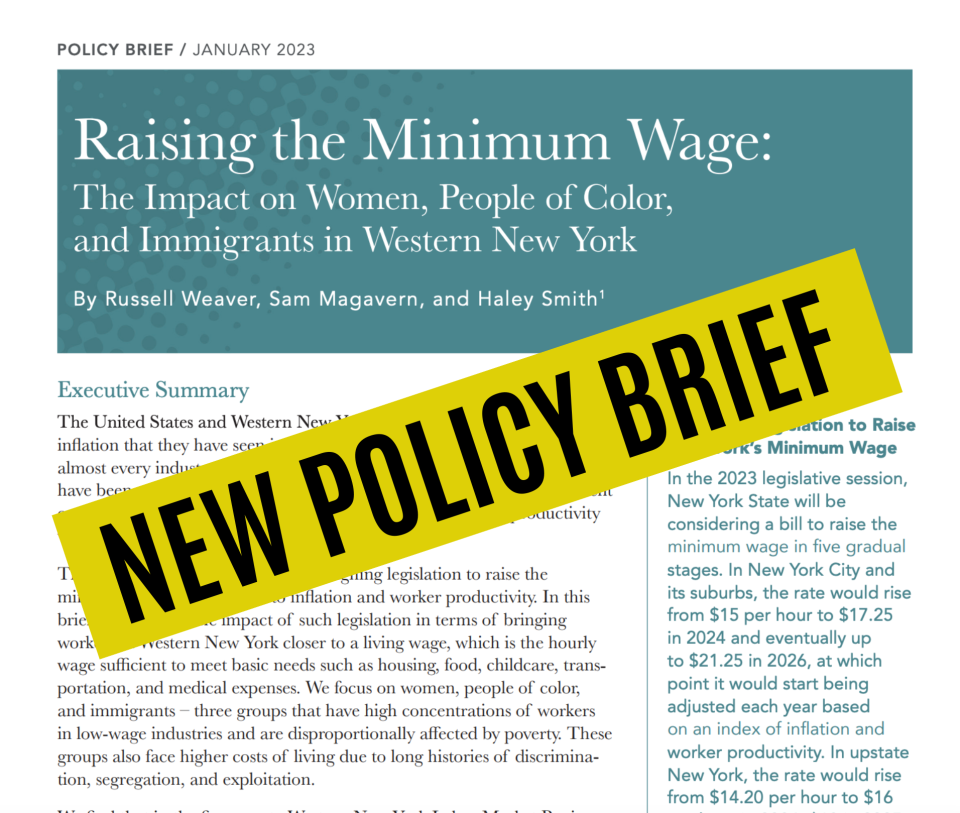News Take Action
New Policy Brief: Raising and Indexing State Minimum Wage Would Have a Large Impact on Women, People of Color, and Immigrants in Western New York
| Date: | January 26, 2023 |
| Share: |

Our latest policy brief by Sam Magavern, Russell Weaver, and Haley Smith examines the potential impact of raising the state's minimum wage for workers in Western New York. The authors conclude that the legislative proposal to raise New York’s minimum wage gradually to $20 by 2026 in upstate New York, catch it up to the statewide rate of $21.25 by 2027, and adjust it each year to keep pace with rising prices and worker productivity growth would go a long way towards moving pay in Western New York closer to a living wage – with tremendous benefits for women workers, workers of color, and foreign-born workers.
“Raising the state’s minimum wage is a powerful tool for making Western New York more equitable and prosperous,” says Russell Weaver, Director of Research at the Cornell ILR Buffalo Co-Lab. “Our research shows that very large numbers of workers – especially women, people of color, and immigrants – are paid wages that are not sufficient to meet basic living expenses. Raising the minimum wage is one of the most efficient ways to make sure that people working full-time are not living in poverty.”
Weaver is one of the authors of a new policy brief from Cornell ILR and the Partnership for the Public Good that examines the potential impact of a proposal currently before the state legislature to raise the minimum wage and index it to rates of inflation and worker productivity. The brief uses a new research tool, the Cornell ILR Wage Atlas, to examine the wages of women, people of color, and immigrants in Western New York and compare them to a “living wage” – i.e., a wage sufficient to meet basic living expenses such as food, rent, and medical care.
The authors find that in the five-county Western New York Labor Market Region, which includes Allegany, Cattaraugus, Chautauqua, Erie, and Niagara Counties:
- The median living wage for a parent with one child is $31.54 per hour – more than twice the current minimum wage for Western New York, which is $14.20 per hour.
- Women have a 39.6 percent chance of earning a living wage, compared to 44.8 percent for men.
- People of color have a 26.3 percent chance of earning a living wage, compared to 45.5 percent for whites.
- Foreign-born residents have a 30 percent chance of earning a living wage, compared to 43.3 percent for U.S.-born residents.
Furthermore, the gap between the minimum wage and a living wage is growing fast, due to rates of inflation not seen for decades. Therefore, the brief concludes, legislation to raise the minimum wage and tie it to inflation and worker productivity would go a long way toward bringing the minimum wage closer to a living wage. Such a policy change is particularly important for groups that have faced a long history of discrimination and inequity in the workplace, such as women, people of color, and immigrants.
Other findings in the brief include:
- Decades of discrimination and segregation create higher costs of living for people of color. As a result, the median living wage for a single parent household in Buffalo living east of Main Street is $44.15 per hour, while the corresponding wage for Erie County as a whole is nearly $10 lower, at $34.34 per hour.
- The combined effects of racial and gender inequality are staggering. Women of color in Western New York have only a 25.6 percent chance or earning a living wage at their jobs. And, for women of color who are single parents, the probability of earning a living wage in Western New York is just 6.4 percent.
The Cornell ILR Wage Atlas for New York State was developed with data from two sources: (1) The MIT Living Wage Calculator; and (2) The U.S. Census Five-Year American Community Survey (ACS) Public Use Microdata Samples (PUMS). The MIT Living Wage calculator uses geographically specific data on the costs of basic necessities to calculate a living wage appropriate to different household compositions (i.e., single parent with one child, two parents with two children, etc.).